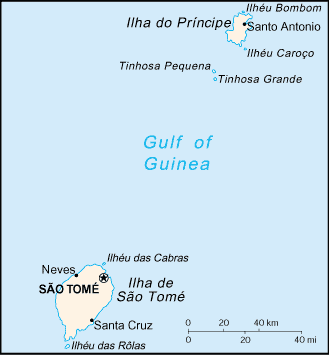São Tomé and Príncipe
Map Courtesy CIA World Factbook
The islands were first discovered by Portuguese navigators between 1469 and 1472. The first successful settlement of São Tomé was established in 1493 by Alvaro Caminha, who received the land as a grant from the Portuguese crown. Principe was settled in 1500 under a similar arrangement. By the mid-1500s, with the help of slave labor, the Portuguese settlers had turned the islands into Africa's foremost exporter of sugar. São Tomé and Principe were taken over and administered by the Portuguese crown in 1522 and 1573, respectively. Sugar cultivation declined over the next 100 years, and by the mid-1600s, São Tomé was little more than a port of call for bunkering ships. In the early 1800s, two new cash crops, coffee and cocoa, were introduced. The rich volcanic soils proved well suited to the new cash crop industry, and soon extensive plantations (roças), owned by Portuguese companies or absentee landlords, occupied almost all of the good farmland. By 1908, São Tomé had become the world's largest producer of cocoa, still the country's most important crop. The roças system, which gave the plantation managers a high degree of authority, led to abuses against the African farm workers. Although Portugal officially abolished slavery in 1876, the practice of forced paid labor continued. In the early 1900s, an internationally publicized controversy arose over charges that Angolan contract workers were being subjected to forced labor and unsatisfactory working conditions. Sporadic labor unrest and dissatisfaction continued well into the 20th century, culminating in an outbreak of riots in 1953 in which several hundred African laborers were killed in a clash with their Portuguese rulers. This "Batepá Massacre" remains a major event in the colonial history of the islands, and the government officially observes its anniversary. By the late 1950s, when other emerging nations across the African Continent were demanding independence, a small group of São Toméans had formed the Movement for the Liberation of São Tomé and Príncipe (MLSTP), which eventually established its base in nearby Gabon. Picking up momentum in the 1960s, events moved quickly after the overthrow of the Salazar and Caetano dictatorship in Portugal in April 1974. The new Portuguese regime was committed to the dissolution of its overseas colonies; in November 1974, their representatives met with the MLSTP in Algiers and worked out an agreement for the transfer of sovereignty. After a period of transitional government, São Tome and Principe achieved independence on July 12, 1975, choosing as its first President the MLSTP Secretary General, Manuel Pinto da Costa. In 1990, São Tomé became one of the first African countries to embrace democratic reform, and changes to the constitution--the legalization of opposition political parties--led to elections in 1991 that were nonviolent, free, and transparent. Miguel Trovoada, a former Prime Minister who had been in exile since 1986, returned as an independent candidate and was elected President. Trovoada was re-elected in São Tomé's second multiparty presidential election in 1996. The Democratic Convergence Party (PCD) toppled the MLSTP to take a majority of seats in the National Assembly, with the MLSTP becoming an important and vocal minority party. Municipal elections followed in late 1992, in which the MLSTP came back to win a majority of seats on five of seven regional councils. In early legislative elections in October 1994, the MLSTP won a plurality of seats in the Assembly. It regained an outright majority of seats in the November 1998 elections. The Government of São Tomé fully functions under a multiparty system. Presidential elections were held in July 2001. The candidate backed by the Independent Democratic Action Party, Fradique de Menezes, was elected in the first round and inaugurated on September 3. Parliamentary elections held in March 2002 led to a coalition government after no party gained a majority of seats. An attempted coup d'état by a few members of the military and the Christian Democratic Front (mostly representative of former São Toméan volunteers from the apartheid-era Republic of South African Army) in July 2003 was reversed by international, including American, mediation without bloodshed. In September 2004, President de Menezes dismissed the Prime Minister and appointed a new cabinet, which was accepted by the majority party.
|
||||||||||||||||
 The Democratic Republic of São Tomé and Príncipe is a tiny two-island nation in the Gulf of Guinea, distanced 140 kilometers from one another, and situated about 250 and 225 kilometers, respectively, off the northwestern coast of Gabon. Both islands are part of an extinct volcanic mountain range. São Tomé, the sizable southern island, is situated almost exactly on the equator. It is named after Saint Thomas Day, the day of its discovery by Portuguese explorers.
The Democratic Republic of São Tomé and Príncipe is a tiny two-island nation in the Gulf of Guinea, distanced 140 kilometers from one another, and situated about 250 and 225 kilometers, respectively, off the northwestern coast of Gabon. Both islands are part of an extinct volcanic mountain range. São Tomé, the sizable southern island, is situated almost exactly on the equator. It is named after Saint Thomas Day, the day of its discovery by Portuguese explorers.